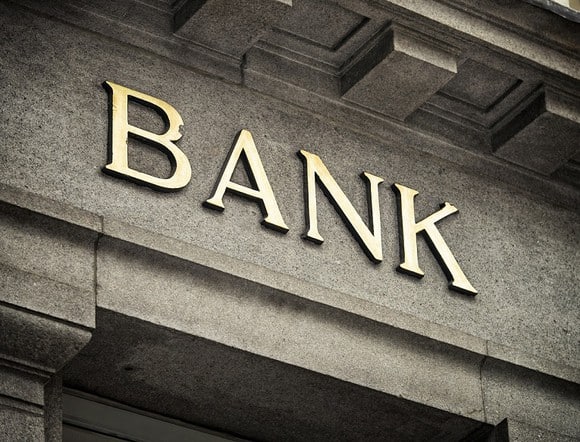
A combination of rising interest rates and lower corporate taxes could be a boon to bank stocks in 2018, but this is an industry where investors can afford to be picky, because the banking industry is unlike any other. With more than 400 banks trading on major American exchanges, investors have the ability to select bank stocks that perfectly align with their view on interest rates, the economy, and credit performance.
Below, three Fool.com investors make the case for adding shares of Fifth Third Bancorp (NASDAQ:FITB), Morgan Stanley (NYSE:MS), and Deutsche Bank (NYSE:DB) to your portfolio.
A bank with more ways to grow profits
Jordan Wathen (Fifth Third Bancorp): It’s my view that the “easy money” for banks has already been earned. After spending years shedding expenses and improving their underwriting models, banks are finally benefiting from rising rates, too. In other words, earnings are likely closer to a peak than a trough for most banks. Not so for Fifth Third Bancorp, which still has room for improvement by growing loans and slashing expenses.
The past year can be described as a “go nowhere” year for Fifth Third, as it put certain commercial and auto loans in runoff, so that outstanding loans actually declined year over year. But these moves helped Fifth Third eliminate undesirable credit risks, while allowing it to focus on its core lines of business. Banks shouldn’t be punished for slow, but responsible, loan growth.
Expenses remain a perennial issue at Fifth Third, as its efficiency ratio has teetered at about 60% for years. Management is cognizant of low-hanging fruit in its expense base, laying out what it calls its “North Star” strategy to get its efficiency ratio below 60%, a dividing line that separates the good regional banks from the great.
Patient investors could be rewarded as Fifth Third grows its loan portfolio and trims expenses, all while sending much of its earnings power back to shareholders in the form of dividends and repurchases. Shares trade at about 1.7 times tangible book value, and less than 14 times consensus earnings estimates for 2018, making Fifth Third a relative value in the regional bank world.
Look beyond your neighborhood bank
Dan Caplinger (BofI Holding): It’s easy for investors to rely on the biggest banks in the U.S. market to produce strong profits, and in an era of rising interest rates, shareholders in those top financial institutions have received plenty of rewards. But for long-term growth prospects, it pays to look beyond the too-big-to-fail banks and see more innovative companies in the financial industry. BofI Holding, the company behind the Bank of the Internet, has seen huge growth over the past five years, building up its deposits by enticing online customers with above-average interest rates.
BofI has the advantage of not having a huge network of physical brick-and-mortar bank locations to maintain and finance, and that allows the company to offer more attractive rates to its customers without squeezing profitability. On the savings side, BofI offers savings and checking accounts as well as certificates of deposit, which help it generate fee revenue and borrow inexpensively. BofI also lends out money, with mortgages, commercial real estate loans, and commercial loans being the bank’s bread-and-butter business.
Online banks have proliferated, but BofI has a first-mover advantage and a catchy name that helps to support its extensive marketing campaigns. With room to grow but an already recognized brand, BofI is in the sweet spot for further growth in the near future.
Banking on an eventual turnaround
Sean Williams (Deutsche Bank): While it’s unlikely to be palatable to all investors given the controversy that’s shrouded it in recent years, I believe risk-taking and value-seeking investors would be wise to give Deutsche Bank another look in April.
The end of last year was a perfect storm for Deutsche Bank. It wound up reporting a monstrous $2.75 billion loss in the fourth quarter, along with a $621 million full-year loss, marking the third straight year the German bank lost money. But it is worth noting that Deutsche Bank would have turned a profit had it not taken a charge in the fourth quarter related to a valuation adjustment on its U.S. deferred tax assets. Nevertheless, investment banking revenue plunged 16% during the fourth quarter, which was worse than analysts expected, and the company’s cost-cutting initiatives aren’t on track to hit previously touted goals in 2018.
That’s the bad news. The good news is that trading revenue was an issue for practically all banks during the fourth quarter of 2017, but shouldn’t be too significant a problem in future quarters. By the same token, the one-time tax charge Deutsche Bank took in the fourth quarter shouldn’t be an overhang. In fact, with roughly a quarter of its business conducted in the U.S., Deutsche Bank should see earnings benefits in the years that lie ahead due to the Tax Cuts and Jobs Act. Even the company’s numerous scandals should be put into the rearview mirror. Banking customers have shown time and again that they have short-term memories when it comes to bad PR.
Assuming interest rates do continue to rise in the U.S. and in parts of Europe, Deutsche Bank could be set up for quite the rebound. By Wall Street’s estimates, the company could once again deliver more than $2 per share in earnings by 2021. This, along with the stock currently trading at 34% of its book value, makes it an intriguing play for investors with a strong stomach and the resolve to wait a good three to five years for the company to turn its business around.
